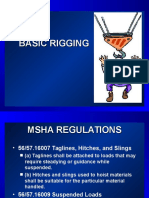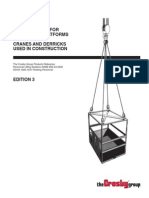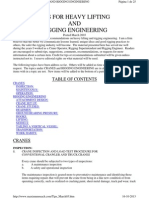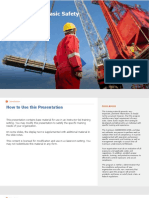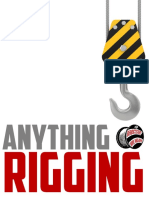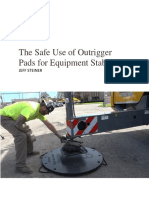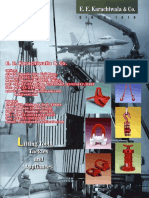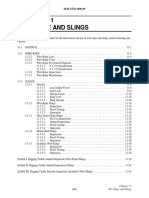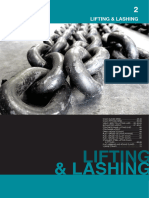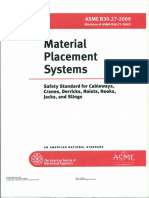83%(6)83% found this document useful (6 votes)
917 views72 pagesRigging Guide
catalogo de rigging
Uploaded by
Alfredo VSCopyright
© © All Rights Reserved
We take content rights seriously. If you suspect this is your content, claim it here.
Available Formats
Download as PDF or read online on Scribd
83%(6)83% found this document useful (6 votes)
917 views72 pagesRigging Guide
catalogo de rigging
Uploaded by
Alfredo VSCopyright
© © All Rights Reserved
We take content rights seriously. If you suspect this is your content, claim it here.
Available Formats
Download as PDF or read online on Scribd
You are on page 1/ 72
RIGGING
ld
COLUMBUS McKINNON CORPORATION
RIGGING
GUIDE
A HANDBOOK FOR RIGGING & HOISTING APPLICATIONS
DISCLAIMER:
THIS GUIDE IS INTENDED FOR GENERAL INFORMATION PURPOSES
ONLY. IT SHOULD NOT BE ASSUMED THAT THIS MATERIAL COVERS ALL
REGULATIONS OR STANDARDS. THIS INFORMATION IS NOT A SUBSTITUTE
FOR REVIEW OF THE APPLICABLE GOVERNMENT REGULATIONS AND
STANDARDS AND SHOULD NOT BE CONSTRUED AS LEGAL ADVICE OR
OPINION BY COLUMBUS MCKINNON CORPORATION, OSHA, ASME OR
WSTDA. THE AUTHOR AND PUBLISHER CANNOT GUARANTEE CORRECTNESS.
OR COMPLETENESS AND ACCEPTS NO RESPONSIBILITY IN THE USE OR
MISUSE OF THIS INFORMATION.
TABLE OF CONTENTS
SLINGS
Sling WfOrrmation .........c. cscs eceeeseeeeeecceeeeseesstesseesereeseeaene
Basic Hitches
Chain Slings
Web Slings
Roundslings .
Wire Rope Slings .
RIGGING HARDWARE & USE
Eye Bolts ...
Heist Rings
Heist Ring & Eye Bolt Use
Shackles ......0. ccc
Shackle & Sling Use
Master Links .
Hook Use ..
Wire Rope Clips
Turnbuckles ......
Clamp Use & Safety oo. ec eneeeeeeee AD
REFERENCE
Tension Calculator .........
Load Angle Tension Chart 47
Drifting Loads
D/d Ratios .
Leverage .
Pulling Force .
Basic Knots ......
Hitch Reductions .
Choke Reductions
Equations
Material Weights
Calculating Weight, Area, Volume & Circumference
Pre-Operational Inspection Checklist .......ccece
HAND SIGNALS ou... eters OO
CONVERSION CHART ...........cccccssesseseceeesesrenteesesarcatnceneneseseee OF
TRAINING. ..0......eccecscceeeeesnseseecee ceeeenesensesencnennessesaeeseansenensesens 68
> SLINGS 4
SLING INFORMATION
All sling working load limits are based on items being in acceptable
condition for use per ASME B30.9, OSHA 1910.184 and the
manufacturer's recommendations.
Rigging equipment is subject to misuse and wear. Itis required by ASME
and OSHA that rigging equipment be inspected on a regular basis by
a competent person designated by the employer. Columbus McKinnon
Corporation recommends a rigger inspect rigging equipment before each
use. Do not use slings or rigging equipment that is damaged or worn
beyond the manufactures recommendations. Refer to OSHA and
applicable ASME standards for rejection criteria.
WLL's are based on the following factors:
1. Type of hitch 4, Angle of loading
2. Material strength 5. Diameter of curvature (D/d)
3. Design factor 6. Fabrication efficiency
ASME B30,.9-1.7.1 (2010) Identification Requirements
All slings shall be marked to show:
1. Sling size 4. Manufacturer name (CM)
2. Sling reach - and grade of sling
3. Working load limit 5. Number of branches
(all slings must be rated
by their weakest component)
Additional marking requirements for:
Wire Rope: diameter or size
Web Slings: synthetic web material used
Chains: grade, chain size, number of legs, length’reach, serial number
Permanently affixed sling ID tags are required
per ASME B30.9 and OSHA 1910.184.
eS
oer tel
ASME 830.9-1.5.3 states “Horizontal sling angles less than 30° shall not
be used as recommended by the sling manufacturer or a qualified person.”
BASIC HITCHES
VERTICAL
| |
Seal
Chain Sling Wire Rope/ Web/
Web Sling Round Sling
(eye & eye) (endless)
same ain cia Lf
(
are
CHOKER
Sling tags and chart
working load limits
are based on the
angle of choke to be
120° or higher
41-5" +/-5°
BASKET
Working load limit
is based on both
legs being within
5° of vertical.
> SLINGS 5
>» SLINGS 6
CHAIN SLINGS (GRADE 80)
120
greater
CT eR TTL (Le
Chain ETc Oe PC)
Trad ee) ig pore
(in.) | Vertical Single a T T
lees od ao
er , 1,700 | 3,600" | 3,000
OE 3,500 2,800 | 6,100 | 4,900 | 3,500
ATG 4,500 3,600 | 7,800" | 6400 | 4,500
EE 7,100 5,700 | 12,300*| 10,000 | 7,100
ie 12,000 9,600 | 20,800" | 17,000 | 12,000
ED 13,100 | 14,500 | 31,300" | 25,600 | 18,100
28,300 22,600 | 49,000" | 40,000 | 28,300
34,200 27,400 | 59,200*| 48,400 | 34,200
47,700 38,200 | 82,600" | 67,400 | 47,700
72,300 57,800 | 125,200"| 102,200 | 72,300
jouble Endless Slings at angle
Single Leg Choker Double Leg Basket
(Vertical) Sling Sling Sling Sling
CHAIN SLINGS (GRADE 80)
TT etn)
SAD Ree eer m RIT
or Double Basket Sling
Eu
Triple Leg Quadruple Leg Double Basket
Bridle Sling Bridle Sling Sling
SLINGS 7
SLIN 8
CHAIN SLINGS (GRADE 100)
Working Load Limit (Ibs.)
Ered
(1 Leg) Double (2 Legs)
Vertical | Choker CEL
Bred
Endless
2,100
3,500
4,500
7,100
9,900" |
15,200"
18,100
28,300
34,200
Bo not se Oi
ways Use |
LLOY 1000
39,100*
61,100*
74,000*
|
|
|
12,000 | 26,000"
|
|
|
Single Leg Choker Double Leg
(Vertical) Sling Sling Sling
CHAIN SLINGS (GRADE 100)
Working Load Limit (Ibs.)
SET ee meer UCR)
Cea
30°
Triple Leg Quadruple Leg Double Basket
Bridle Sling Bridle Sling Sling
>» SLINGS 9
>» SLINGS 10
WEB SLINGS €YE-AND-EYE SLING
EE LIGHT DUTY (CLASS 5) (1-PLY & 2-PLY)
Sues Working Load Limit (Ibs.)
bar ha hie) ee Vertical Basket
1-PLY, CLASS 5, EE LIGHT DUTY
1,100 a0 | 2,200
1,600 | 1,280 | 3,200
1,900 1,520 | 3,800
2,200 | 1,760 | 4,400
3,300 2,640 | 6,600
4,400 | 3,520 | 8,800
5,500 4,400 | 11,000
6,600 | 5,280 ee)
2-PLY, CLASS 5, EE LIGHT DUTY
2,200 ] 1,760 ] 4,400
3,300 2,640 | 6,600
3,800 | 3,040 | 7,600
4,400 3,520 | 8,800
6,600 | 5,280 | 13,200
8,200 6,560 | 16,400
10,200 | 8,160 | 20,400
12,300 | 9,840 | __ 24,600
Abwrays verify in
Copyright 2004 b 19 & Tie Down Association
WEB SLINGS €YE-AND-EYE SLING
EE LIGHT DUTY (CLASS 5) (1-PLY & 2-PLY)
\\ aN AN
SUL TL
Sling Size Double (2 Legs)
oe) iy 45° 30°
1-PLY, CLASS 5, EE LIGHT DUTY
1,905 | 4,555 1,100
2771 2,262 1,600
3,291 | 2,687 1,900
3,810 3411 2,200
5,716 | 4,666 3,300
7,621 6,222 4,400
9,526 | 1777 5,500
11,431 9,332 6,600
3,810 3,111 2,200
5,716 | 4,666 3,300
6,582 5,373 3,800
7,621 | 6,222 4,400
11,431 9,332 6,600
14,202 =| 11,595 8,200
17,666 14,423 10,200
21304 | 17,302 | =~ 12,300
jon on sling tag
19 & Tle Down Association
>» SLINGS 11
>» SLINGS 12
WEB SLINGS €YE-AND-EYE SLING
EE HEAVY DUTY (CLASS 7) (1-PLY & 2-PLY)
ASU
BT ES Vertical
08] es
1-PLY, CLASS 7, EE HEAVY DUTY
i 1,600 1,280 3,200
rate 2,300 1,840 4,600
ORI 2,700 2,160 5,400
2 3,100 2,480 6,200
Fi] 4,700 3,760 9.400
E} 6,200 4,960 12,400
5 7,800 6,240 15,600
Li 9,300 7,440 18,600
Ei} 11,800 9.440 23,600
14,700 11,760 29,400
17,600 14,080 35,200
2-PLY, CLASS 7, EE HEAVY DUTY
3,100 2,480 6,200
4,700 3,760 9,400
5,400 4,320 10,800
6,200 4,960 12,400
8,800 7,040 17,600
11,000 8,800 22,000
13,700 10,960 27,400
16,500 13,200 33,000
22,700 18,160 45,400
28,400 22,720 56,800
34,100 | 27,280 68,200
non sling tag
ig & Tie Down Assoctation
WEB SLINGS €YE-AND-EYE SLING
EE HEAVY DUTY (CLASS 7) (1-PLY & 2-PLY)
I AN AN
Synthetic TT CTT ED
BST er Dee)
Cd cM Ed
1-PLY, CLASS 7, EE HEAVY DUTY
2,771 2,262 1,600
3,984 3,252 2,300
4,676 3,818 2,700
5,369 4,383 3,100
8,140 6,646 4,700
10,738 8,767 6,200
13,510 11,029 7,800
16,108 13,150 9,300
20,438 16,685 11,800
25,460 20,786 14,700
30,483 24,886 17,600
2-PLY, CLASS 7, EE HEAVY DUTY
i 5,369 4,383 3,100
iar 8,140 6,646 4,700
phe} 9,353 7,636 5,400
3 10,738 3,767 6,200
3 15,242 12,443 8,800
E 19,052 15,554 11,000
5 23,728 19,372 13,700
6 28,578 23,331 16,500
Ei} 39,316 32,098 22,700
49,189 40,158 28,400
59,061 48,217 34,100
non sling tag
ng & Tie Down Association
>» SLINGS 13
>» SLINGS 14
WEB SLINGS ENDLESS SLING
EN LIGHT DUTY (CLASS 5) (1-PLY & 2-PLY)
Sues Working Load Limit (Ibs.)
bar ha a ite) Pet cig Vertical Basket
1-PLY, CLASS 5, EN LIGHT DUTY
2,200 1,760 | 4,400
3,200 | 2,560 | 6,400
3,800 3,040 | 7,600
4,400 | 3,520 | 8,800
6,600 5,280 | 13,200
8,800 7,040 | 17,600
11,000 8,800 | 22,000
13,200 | 10560 | 26,400
2-PLY, CLASS 5, EN LIGHT DUTY
4,400 ] 3,520 ] 3,800
6,600 5,280 | 13,200
7,600 | 6,080 | 45,200
8,800 7,040 | 17,600
13,200 | 10560 | 26,400
16,400 13,120 | 32,800
20,400 | 16320 | 40,800
24,600 | 19,680 | 49,200
ys verity in jon on sling tag
Copyright 201
WEB SLINGS ENDLESS SLING
EN LIGHT DUTY (CLASS 5) (1-PLY & 2-PLY) (TYPE V)
ern Working Load Limit (Ibs.)
ST trad ‘Two Leg or Single Basket
(in) ry |
3,810 3,111 2,200
5,542 4,525 3,200
6,582 5,373 3,800
7,621 6,222 4,400
11,431 9,332 6,600
15,242 12,443 8,800
19,052 15,554 11,000
22,862 18,665 13,200
7,621 6,222 4,400
11,431 9,332 6,600
43,163 10,746 7,600
15,242 12,443 8,800
22,862 18,665 13,200
28,405, 23,190 16,400
35,333 28,846 20,400
42,607 34,784 24,600
jon on sling tag
Copyright 201
>» SLINGS 15
19 & Tle Down Association
>» SLINGS 16
WEB SLINGS ENDLESS SLING
EN HEAVY DUTY (CLASS 7) (2-PLY)
A Us LT rE aT Lt)
bar ha Endless Vertical Feed Vertical Basket
i 6,200 12,400
AEE 9,400 7,520 18,800
oer) 10,800 | 8,640 21,600
12,400 9,920 24,800
17,600 | 14,080 35,200
22,000 17,600 44,000
27,400 | 21,920 54,800
33,000 26,400 66,000
42,350 | 33,880 84,600
52,900 42,320 105,800
63,500 | 50,800 127,000
jon on sling tag
Neb Sling & Tie Dawn Association
WEB SLINGS ENDLESS SLING
EN HEAVY DUTY (CLASS 7) (2-PLY) (TYPE V)
KN 4S as
ST en CL LL LD
SS Ed Un Rms mec
8) ri
i] 10,738
aoe 16,281 | 13,262 9,400
1-3/4 18,706 15,271 10,800
21,477 | 17,534 12,400
30,483 24,886 17,600
38,104 | 31,108 22,000
47,457 38,744 27,400
97,156 46,662 33,000
74,801 59,812 42,300
91,623 | 74,801 52,900
109,982 | 89,789 63,500
Association
>» SLINGS 17
>» SLINGS 18
ROUNDSLINGS
FOR VERTICAL & CHOKER HITCHES
be
Working Load Limit (Ibs.) Minimum Diameter
nad alate: ] be cg ar ir tsi
2,600 2,100 5 12
5300 | 4200 | 625 | 5/8
8400 | 6,700 5 | 3i4
io600 | 8500 | 875 | 78
13,200 | 10,600 1 | 1
16.800 | 13400 | 1425 | 1-4/8
21,200 | 17,000 137500 4-316
25,000 | 20000 | 125 | 1-1/4
31,000 | 24,800 15 | 1-4/2
40,000 | 32,000 | 1625 | 1-5/8
53,000 | 42,400 2 | 2
66,000 | 52800 | 2125 | 2-1/8
90,000 | 72000 | 25 | 24/2
hackles and
Copyright 1994 by Web Sling & Tle Day
Association
ROUNDSLINGS
FOR BASKET HITCHES
lace
PCLT} Load AT ia) | DE
PEEL 7 Decimals| Fractions
90° | 60° 45° ig (in.) ccm)
5,200 | 4,500 | 3,700 | 2,600 625 5/8
g 10,600 9,200 7,500 5,300 875 7/8
16,800 | 14,500 | 11,900 | 8,400 | 1.0625 | 1-116
21,200 | 18,400 | 15,000 | 10,600 | 1.25 | 1-44
26,400 | 22,900 | 18,700 | 13,200 | 1.375 | 1-9/8
33,600 | 29,100 | 23,800 | 16,800 | 1.625 | 1-5/8
| 42,400 | 26,700 | 30,000 | 21,200 | 1.625 | 1-5/8
50,000 | 43,300 35,400 | 25,000 1.875, 1-7/8
EWE 62,000 | 53,700 | 43,800 | 31000 | 2 2
FT 80,000 | 69,300 | 56,600 | 40,000 | 2375 | 2-9/8
FR 106,000 | 91,800 | 74,900 | 53,000 | 2.75 | 2-3/4
[FM 132,000 | 114,300 93,300 | 66,000 | 3 3
FEM 180,000 | 155,900 | 127,300 | 90.000 | 35 | 3-4/2
Caw ne acd
of shackles and
Copyright 1994 by Web Sling & Tie Down Assoctation
LINGS 19
>» SLINGS 20
WIRE ROPE SLINGS) 6x19 and 6x36 Class
EIPS - MS - IWRC
(extra improved plow steel, mechanical splice,
independent wire rope core)
nie) Working Load Limit (tons)
any roe A en
; er eeu 90°
14 0.65 0.48 1.30
Ai) 1.00 0.74 2.00
Re 1.40 110 2.90
Pic) 1.90 1.40 3.90
1/2 2.50 1.90 5.10
EAL 3.20 2.40 6.40
AE 3.90 2.90 7.80
Ez 5.60 4.10 11.00
rE} 7.60 5.60 15.00
i 9.80 7.20 20.00
ere 12.00 9.10 24.00
GEL 15.00 11.00 30.00
ea 18.00 13.00 36.00
ere 21.00 16.00 42.00
fe 24.00 18.00 49.00
ey 28.00 21.00 57.00
eit 32.00 24.00 64.00
28.00 [ 73.00
WIRE ROPE SLINGS) 6x19 and 6x36 Class
EIPS - MS - IWRC
(extra improved plow steel, mechanical splice,
independent wire rope core)
ence) Se ee A elt]
Pd)
(in) | Basket 60° | Basket 30° = cea
ce 0.65 0.82 0.48
EAL] 1.70 1.00 1.30 0.74
iy 2.50 1.40 1.80 1.10
al 3.40 1.90 2.50 1.40
4 4.40 2.50 3.20 1.90
CTA 5.50 3.20 4.10 2.40
BE 6.30 3.90 5.00 2.90
RL 9.70 5.60 7.10 4.10
3 13.00 7.60 9.70 5.60
i 17.00 9.80 13.00 7.20
ed 21.00 12.00 16.00 9.10
ious 26.00 15.00 19.00 11.00
Loic) 31.00 18.00 23.00 13.00
1-1/2 37.00 21.00 28.00 16.00
ed 42.00 24.00 32.00 18.00
1-3/4 49.00 28.00 37.00 21.00
1-7/8 56.00 32.00 42.00 24.00
63.00 37.00 48.00 28.00
standards
“onsult
ysuse the sling tag for the
ij Manufacturer,
na. minimum ud of 25:1
Values listed in US tons.
>» SLINGS 21
LINGS 22
3 - LEG BRIDLE 6x19 and 6x36 Class
EIPS - MS - IWRC
(extra improved plow steel, mechanical splice,
independent wire rope core)
Horizontal
Angle 6
mit)
Working Load Limit (tons)
fs Vertical 6 age
ey 1.70
5/16 3.00 2.60 240 1.50
3/8 4,20 3.70 3.00 2.20
rat 5.80 5.00 410 2.90
7 7.60 6.60 5.40 3.80
OGG 9.60 8.30 6.80 4:80
5/8 12.00 10.00 8.30 5.90
ET 17.00 15.00 12.00 8.40
rT) 23.00 20.00 16.00 11.00
1 28.00 26.00 21.00 15.00
ETM 36.00 31.00 26.00 18,00
NM 44.00 38,00 31.00 22.00
me 53.00 46,00 38.00 27.00
IM 63.00 56.00 45.00 32.00
eed 73,00 63.00 52.00 37.00
TM 25.00 74,00 50.00 42.00
97.00 34.00 68.00 48.00
110.00 95.00 78.00 55.00
}@ sling tag for the
facturer.
Values listed In US tons,
4 - LEG BRIDLE 6x19 and 6x36 Class
EIPS - MS - IWRC
(extra improved plow steel, mechanical splice,
independent wire rope core)
Horizontal
Angle
Mite) eel
: Working er Limit (tons)
rd) ,
(in) | Vertical 60° ce Kl
rc) . J .
EYAL 3.5 28 2.0
et] 5.0 4] 2.9
ral 6.7 5.5 3.9
es 8.8 7A 5.1
EAL} 11.0 9.0 64
Bd 14.0 11.0 78
KL) 19.0 16.0 11.0
uc 26.0 21.0 15.0
i 34.0 28.0 20.0
Let) 42.0 34.0 24.0
Lowi 51.0 42.0 30.0
ee) 62.0 50.0 36.0
er 13.0 60.0 42.0
1-5/8 85.0 69.0 49.0
ee 98.0 80.0 57.0
91.0 64.0
104.0 73.0
Values listed in US tons,
LINGS 23
>» SLINGS 24
WIRE ROPE SLINGS) 6x19 and 6x36 Class
EEIPS - MS - IWRC
(extra extra improved plow steel, mechanical splice,
independent wire rope core)
A “
nie) Working Load Limit (tons)
any roe A en
; er) Choker 90°
v4 071 0.52 1.40
Ea 1.10 0.81 2.20
Er) 1.60 | 1.20 3.20
fic) 2.10 1.60 4.30
1/2 2.80 | 2.00 5.50
Ea 3.50 2.60 7.00
AE 4.30 | 3.20 8.60
6.20 4.50 12.00
8.20 | 6.10 17.00
11.00 8.00 22.00
2 the sling tag for the
anutacturel,
na minimum Oud of 25:1
Values listed in US tons.
WIRE ROPE SLINGS) 6x19 and 6x36 Class
EEIPS - MS - IWRC
(extra extra improved plow steel, mechanical splice,
independent wire rope core)
PTs) ML Be MALL etd)
ih T | STReT
COMES cu ce ig mwa owers
Ce
a 071 0.52
aa | 1.10 140 | 081
ET) 270 | 1.60 2.00 | 1.20
ial 370 | 2410 2.70 1.60
12 480 | 280 3.50 2.00
iG 610 | 3.50 4.50 2.60
5/8 750 | 430 5.50 3.20
11.00 | 620 7.90 | 4.50
1400 | 8.30 11.00 6.10
19.00 | 11.00 14.00 | 8.00
rt use the sling tag tor the
isull sling manufacturer.
ed on a minimum Ovd of 25:1
>» SLINGS 26
WIRE ROPE SLINGS) 6x19 and 6x36 Class
EIPS - MS - Fiber Core
(extra improved plow steel, mechanical splice, fiber core)
Ae a
PT ST mem a Oy)
rit At Se Basket
; (1 Leg) nyc Er
ac 0.42 1.10
SAG 0.66 1.70
BE 0.94 2.50
rial} 1.30 3.40
1.60 4.40
2.10 5.50
2.60 6.80
3.70 9.70
5.00 13.00
6.40 17.00
8.10 21.00
9.90 26.00
3
Ea
BE]
na minimum Dud of 25
Values listed In US.
WIRE ROPE SLINGS) 6x19 and 6x36 Class
EIPS - MS - Fiber Core
(extra improved plow steel, mechanical splice, fiber core)
ee Pu URAL a )]
Size | T |
(in.) | Basket 60° | Basket 30°
cs
56
i
Al
4
Eyal
BE
Ls
i:
oe
ed
MRE
Ce es
8.10
22.00 9.90
g tag for the
a minimum Od of 25:1
>» SLINGS 27
>» RIGGING HARDWARE & USE 28
EVE BOLTS
SHOULDER EYE BOLTS WORKING LOAD LIMIT
ANGLE TO HORIZONTAL
75°
55% of full
rated load
Less than
bo 45 T USE
DO NOT USE AT ANGLES LESS THAN 45°
Working Load Limit (Ibs.)
0° Fie
ait Ean ry
Pend aye errgtl
ee 500 275 175
Paar) 900 495 315
rT 1,300 715 455 325
Tear 1,800 990 630 450
Tae) 2,400 1,320 840 600
Arran 4,000 2,200 1,400 1,000
3/4.x10 5,000 2,750 1,750 1,250
7/8x9 7,000 3,850 2,450 1,750
ru 9,000 4,950 3,150 2,250
cere 12,000 6,600 4,200 3,000
14x 15,000 8,250 5,250 3,750
Err 21,000 11,550 7,350 5,250
Aways consult manutacturer’s loads charts before using eye bolts
HEAVY DUTY® HOIST RINGS
FORGED
* NOTE: Know your sling tensions
See ar cop eo Me me PTET CE LB
(in.) (Ibs.) (Ibs.-ft.) we
1/4-20
Cee
El ea)
teak
el
Ea
ea
78-9
ie]
1-1/4-7
Di ta]
1-1/2-6
2-4-1/2
fk)
* Heavy Duty® is red tradernark of American Drill Bushing,
registe
Aways verity
» RIGGING HARDWARE & USE 29
turer's information prior to use.
>» RIGGING HARDWARE & USE 30
SPECIALTY ENGINEERED
HOIST RINGS
MACHINED
NOTE: Know your sling tensions
RCE COMMU E LC Bm) DIT a 1
3) (Ibs.) f D M
bc er) 550 0.43 0.38 1.33
Yale ReeaL Ed 800 0.43 0.38 1.27
EE 1,000 0.43 0.38 1.21
sree) 2,500 0.88 0.75 2.31
reo) 2,500 0.88 0.75 4.25
5/8 -11 4,000 0.83 0.75 2.18
Tien 4,000 0.88 0.75 4.12
3/4-10 5,000 0.88 0.75 2.06
EC aL) 5,000 0.88 0.75 4.00
3/4-10 7,000 1.40 1,00 3.06
3/4-10 7,000 1.40 1.00 4.65
ite] 8,000 1.40 1.00 2.93
7/8 -9 8,000 1.40 1.00 4.52
a tI 10,000 1.40 1.00 2.81
et] 10,000 1.40 1.00 4.40
1-1/4-7 15,000 1.75 1.25 4.12
pee] 24,000 2.25 175 6.41
2-4-1/2 30,000 2.25 1.75 5.41
Pt th] 50,000 3.00 2.25 8.03
2-1/2-4 50,000 3.00 2.25 8.03
ee 75,000 3.75 2.75 8.48
100,000 4.00 3.25 9.28
facturer’s information prior to use
HOIST RINGS (METRIC)
METRIC
NOTE: Know your sling tensions
Thread Size | Rated Load | Torque Load | Dimensions (mm)
(kg.)
Tt)
1S a Bea]
M8 x 1.26
M10 x 1.5
Wire eee
We ea
re a)
2)
ren
WED es)
Wu
ee AY
esd
M48 x 5.0
] wa ol
9.50
9.50
16.00
37.00
80.00
135.00
135,00
311.00
311.00
637.20
1,085.50
1,085.50
1,085.50
Always verity manufacturer's information prior to usa,
> RIGGING HARDWARE & USE 31
RIGGING HARDWARE & USE 32
HOIST RING & EYE BOLT USE
MINIMUM ENGAGEMENT DEPTH
Hoist rings and eye bolts should be
threaded into the surface a minimum
of 1-1/2 times the thread diameter.
NEVER USE wasters
or Spacers between the
thownting surtace and
the bushing flange
“Minimum
Engagement Deth
7 A Minium
Engagement Depth
_¥.1-1/2 x diameter
1-1/2 x diameter
Example:
The minimum engagement depth for an eye bolt with a 1/2" diameter would be 3/4"
ALWAYS PULL LOAD IN THE PLANE OF THE EYE
Never go below 45° side pull
INCORRECT
CORRECT
SIDE LOADING
Vertical pull should be
CORRECT
INCORRECT
CORRECT Bolt will bend!
used whenever possible,
Only shoulder eye bolts
may be side loaded.
NON-SHOULDERED
YE BOLT
Vertical pull only
* per ASME 820.26-2.9.4.2 “when used in a tapped blind hole, the effective thread length shall
be at least 1-1/2 times the diameter of the bold tor engagement in steel... For other thread
angagements or In other materlals, contact the aye ball manufacturer or a qualified persan”
Always verity manufacturer's Information prior to usa:
SHACKLES
CARBON
Shackles are designed and rated for in-line applied
tension. You can attach multiple slings in the
body of a shackle without reducing the capacity,
provided that the shackle is symmetrically loaded
and the included angle does not exceed 120°. +
wae ‘7a Te Ts
S) (Ibs.) 9) Ui)
1/3 667 0.25 0.38
We 1,000 031 0.47
3/4 1,500 0.38 0.53
1 2,000 0.44 0.66
1-1/2 3,000 0.50 0.72
2 4,000 0.63 0.84
3-1/4 6,500 075 1.06
4-3/4 9,500 0.88 1.28
6-1/2 13,000 1.00 1.44
8-1/2 17,000 113 172
9-1/2 19,000 1.25 1.84
12 24,000 1.38 2.03
13-1/2 27,000 1.50 2.25
7 34,000 1.63 241
20 40,000 175 2.66
25 50,000 2.00 2.94
aa 70,000 2.25 3.28
55 110,000 2.75 4.13
85 170,000 3.25 5.00
120 240,000 3.75 5.50
Atvays verity manufacturer
> RIGGING HARDWARE & USE 33
information prior to use
>» RIGGING HARDWARE & USE 34
SHACKLES
SUPER STRONG CARBON
Higher WLL than Standard Carbon
Shackles are designed and rated for in-line applied
tension. You can attach multiple slings in the
body of a shackle without reducing the capacity,
provided that the shackle is symmetrically loaded
and the included angle does not exceed 120°. t
14 28,000 1.38 2.03
7 34,000 1.50 2.25
20 40,000 1.63 241
24 48,000 1.75 2.66
30 60,000 2.00 2.94
35 70,000 2.25 3.28
55 110000 | 275 | 443
F's information prior to use.
SHACKLES
ALLOY
Shackles are designed and rated for in-line applied
tension. You can attach multiple slings in the body
of a shackle without reducing the capacity, provided
that the shackle is symmetrically loaded and
the included angle does not exceed 120°. +
Une a Ts
co (in.)
2 4,000 0.44 0.66
2.6 5,200 0.50 0.72
3.3 6,600 0.63 0.84
5 10,000 0.75 1.06
7 14,000 0.88 1.28
9.5 19,000 1.00 1.44
12.5 25,000 1.13 1.72
15 30,000 1.25 1.84
18 36,000 1.38 2.03
21 42,000 1.50 2.25
25 50,000 1.63 241
30 60,000 1.63 241
29 58,000 1.75 2.66
TE la 35 70,000 1.75 2.66
he 34 68,000 2.00 2.94
iC la 40 80,000 2.00 2.94
43 86,000 2.25 3.28
50 100,000 2.25 3.28
85 170,000 2.75 4.13
120 240,000 3.25 5.00
Pin style only“ Ball, Nut & Cotter style only
facturer's information prior to use.
RIGGING HARDWARE & USE 35
RIGGING HARDWARE & USE 36
SHACKLE AND SLING USE
USING MULTIPLE
SLINGS
Multiple slings within the body
of a shackle shall not exceed
120° included angle
SIDE LOADING
When side loading a shackle with a single sling, the rated WLL will be reduced in accordance
with the manufacturer's recommendation or a qualified person. ASME 830.26 recommends
reducing the capacity of a side loaded shackle from 30% to 50% as shown below,
WLL REDUCTIONS
FOR ALL SHACKLE STYLES SIZES 3/16" TO 3"
PNT a Working Load
CU Et esi CU eee 0% WL Reduction
0 to 10° 45°
11° to 20° 30% WLL Reduction
21° to 30°
31 to45°
46° to 55°
56 to 70°
71 to. 90°
ee oR Brent a]
Always verlty manufacturer's information prior to use.
SHACKLE AND SLING USE
CONNECTING SLINGS TOGETHER
Ashackle may be used to
connect slings together.
Se ee elle
PROTECT YOUR SLING
FROM CORNERS & SHARP EDGES
These safe practices apply to all types of slings:
‘Sharp corners can cut into slings
resulting in high risk of failure and
permanent damage to the sling.
To protect the sling, Change the
sharp edges and comers profile of a comer
that come In contact in contact with a
the sling should be sling to a radius
padded with material of with padding.
sufficient strength.
RIGGING HARDWARE & US
RIGGING HARDWARE & USE
SHACKLE USE
Attach multiple sling legs to the bow, When point loading shackle
not to the pin. This can damage and to shackle, connect:
weaken the sling. Bow to Bow or Bow to Pin
The bow of shackle
Loading should stay should be put into the bit
centered and/or in line. of a choke.
1" shackle
with
3/4" wire rope
The shackle must be To avoid pinching and binding
equal to or larger than of synthetic slings, shackle
the wire rape diameter. must be large enough.
MASTER LINKS
‘Maximum
included angke
120"
CO
GRADE 80
Dimensions (in.)
GRADE 100
Dimensions (in.)
Atways verity fer's information prior to use.
> RIGGING HARDWARE & USE 39
RIGGING HARDWARE & U
HOOK USE
HOOK LATCHES
55
CORRECT INCORRECT
Hook latches (when required) must be in
good working condition. If not, the haok
should be removed from service,
DUPLEX HOOKS.
Must be loaded equally on both sides
ie
CORRECT INCORRECT
"
90° MAX a
INCLUDED ANGLE
FOR HOOKS
Always verity manufacturer's information prior to use.
NEVER TIP LOAD
A HOOK! +
t
ed
INCORRECT CORRECT
#
SELECTING :
THE RIGHT SIZE
HOOK/SLING
Be sure the component is
of adequate size and shape
‘80 that it can be property
‘seated in the saddle of
hook or lifting device.
&
Use a shackle when working
with low horizontal angles.
Shackles can be used with
angles up to 120°.
WIRE ROPE CLIPS
piste | Woot Clips | Turnback Peg )
(iP) (in) erent]
Tr)
RAL)
1/4
5/16
Et
at
4
ea
Ett
EL
78
u
PROPER USE OF WIRE ROPE CLIPS
Ueg WEN ywunwe [Wve Side
¢ = WRNRERURERRNOMEY ES
NOTE: Mechanica
sare the prefer
sof clips to form
1
WARNING
NEVER INSTALL THE U-BOLT ON THE LIVE SIDE!
Coamazdtian.. os
IMPROPER USE
OF WIRE ROPE CLIPS
Always ve
> RIGGING HARDWARE & USE 41
cturer’s information prior to use
> RIGGING HARDWARE & USE 42
TURNBUCKLES
Eye & Eye
Jaw & Eye
Working Load Limit (Ibs.)
End Fitting Types
eas) CaS Ce elo
be eds Seca
WARNING
TURNBUCKLES TO BE USED FOR
re atl eme hg
facturer’s information prior to use,
CLAMP USE & SAFETY
FACTORS TO CONSIDER
WHEN SELECTING A CLAMP:
© Weight of material
* Hardness of material
© Type of material
* Orientation & position of material
* Can material be marked? Is a non-marking clamp required?
Max plate hardness is 300 Brinell (32HRc)
(For clamps with teeth — If hardness exceeds 300 brinelf
4 non-marking clamp will be needed.)
VERTICAL PLATE CLAMPS
FOR LIFTING PLATES
* For lifting long plates,
two clamps and a lifting
beam must be used
* For lifting short plates,
a single clamp can be used
Clamps have maximum and
minimum loading.
If minimum loading is not marked
‘on clamp, never lift below 20%
of the maximum WLL.
Plate at full depth and
Never side load clamp that does lever iockad in postion
hot have a hinged hook ring.
VERTICAL PLATE CLAMPS Lifting sling must be
vertical for all positions
FOR TURNING OVER PLATES.
* Plate must be in contact
with back of clamp
If locking lever is uppermost it
is necessary to lift the clamp
when sliding onto the
plate to allow free
movement of the jaw
Ensure full depth of grip with Take extra care when clamp takes
locking lever in locked position least waight at “top dead center”
>» RIGGING HARDWARE & USE 43
>» RIGGING HARDWARE & USE 44
CLAMP USE & SAFETY
HORIZONTAL PLATE CLAMPS a
4
* For lifting long plates, “
‘two clamps and a lifting
or spreader beam
FOR LIFTING
must be used
+ For lifting short plates, LONG PLATES
asingle clamp FOR LIFTING
can be used SHORT PLATES
* DO NOT USE 4 LEG SLINGS
* DO NOT USE ENDLESS
CHAIN SLINGS.
GIRDER/SECTION CLAMPS
* For long girders use 2 clamps and a lifting beam
* For short sections one clamp may be used
Jaw should be in contact
with sufficient area to
grip load safely
Front clamp should be
in contact with load
* DO NOT USE A VERTICAL CLAMP
TO LIFT I-TYPE BEAMS
SCREWLOK BEAM CLAMPS
© The tips of the side plates
should touch the beam flange.
The load is transmitted into the
beam and away from the edge
© Used for attaching hoists
to |-beams.
© DO NOT USE AS A LIFTING
DEVICE TO LIFT I-BEAMS CORRECT INCORRECT
TENSION CALCULATOR
BY USING ANGLES Tenn
Here is how to calculate the tension ev
ona sling when used at angles other
than 90° vertical.
en
Step 1:
Identify the Load Angle Factor
(L.A.F) based on the horizontal angle.
Step 2:
Use the formula below
(Weight = No. of legs) x L.A.F.
Example: If the load weight is 8,000 Ibs.
and three (3) slings are used
at a 60° angle each:
(8,000 = 3) x 1.155 = 3,080 Ibs,
Therefore, each leg will have
3,080 Ibs. of tension.
Note: When using 3 or 4 leg
slings, it is possible that
only 2 of the legs may
see loading. Therefore,
it ls common practice to
calculate tensions using
only 2 legs to be sure no
overload occurs.
Horizontal
Angle
Atways verity calculations with a qualified person
>» REFERENCE 45
plata ip ih Ol 46
TENSION CALCULATOR
BY USING MEASUREMENTS
When working in the field, determining the exact horizontal
angles can be difficult.
We can calculate the tension based on what
information we do know, and apply this formula:
(Weight += Number of legs) x (S + H)
Example: The load weight is 12,000 Ibs. and two (2) slings are used.
‘You measure up the sling 48" (the “S" dimension) and then measure
‘straight down and get a 30" measurement (the “H" dimension)
(12,000 = 2) x (48 + 30) = 9,600 ibs, of tension per leg
6,000 x 1.6 = 9,600 Ibs. of tension per leg (1.6 is the calculated LA.F)
Therefore, each leg will have 9,600 Ibs. of tension.
Note: When using 3 or 4 leg slings, itis possible that only 2 of the legs
may see loading. Therefore, it is common practice to calculate
tensions using only 2 legs to be sure no overload occurs.
Abways verity calculations with a qualified person
LOAD ANGLE TENSION CHART
Load on Each Leg (Ibs.)
eT] ul (Load Angle Factor)
cd
(1.414)
100 200 141 116 104 100
200 400 283 231 207 200
300 600 424 347 311 300
400 800 566 462 414 400
500 1,000 707 578 518 500
600 1,200 848 693. 621 600
700 1,400 990 809 725 700
800 1,600 1,131 924 828 800
900 1,800 1,273 1,040 932 900
1,000 2,000 1,414 1,155 1,035 1,000
1,100 2,200 1,555 1,271 1,139 1,100
1,200 2,400 1,697 1,386 1,242 1,200
1,300 2,600 1,838 1,502 1,346 1,300
1,400 2,800 1,980 1,617 1,449 1,400
1,500 3,000 2,121 1,733 1,553 1,500
1,600 3,200 2,262 1,848 1,656 1,600
1,700 3,400 2,404 1,964 1,760 1,700
1,800 3,600 2,545 2,079 1,863 1,800
1,900 3,800 2,687 2,195 1,967 1,900
2,000 4,000 2,828 2,310 2,070 2,000
2,100 4,200 2,969 2,426 2,174 2,100
2,200 4,400 3,111 2541 2.277 2,200
2,300 4,600 3,252 2,657 2,381 2,300
2,400 4,800 3,394 2772 2,484 2,400
2,500 5,000 3,535 2,888 2,583 2,500
Atways verity tension calculations with a qualified person
psig ip ih LO] 47
plata ip ih Ol 48
DRIFTING LOADS
To calculate the amount of tension on chainfalls used
in angular rigging applications, the following formula
should be used:
TENSION ON CHAINFALL “A” =
(Load Weight x DB x LA) = (H x DT)
TENSION ON CHAINFALL “B” =
(Load Weight x DA x LB) = (H x DT)
Tension on
Tension on Chaintall “B*
Chaintall “A”
The GM Hurricane 360° hand chain heist is ideal for oad drifting
a ee Se el
CHAINFALLS POSITIONED AT THE SAME ELEVATION
Abways verity calculations with a qualified person
EXAMPLE OF A LOAD DRIFT
WITH VALUES USED:
DA = 36" DB = 60" DT = 96"
LA = 96" LB = 120" H =60"
Load Weight = 1,500 Ibs
EXAMPLE CALCULATIONS
Tension for CM Hurricane 360° Chainfall “A” =
(Load x DB x LA) + (H x DT)
(1,500 Ibs. x 60" x 96") = (60" x 96")
(8,640,000) = (5,760)
1,500 Ibs. of tension on CM Hurricane 360° Chainfall “A”
Tension for Hurricane 360° Chainfall “B” =
(Load x DA x LB) + (H x DT)
(1,500 Ibs. x 36" x 120") + (60" x 96")
(6,480,000) = (5,760)
1,125 Ibs. of tension on CM Hurricane 360° Chainfall “B”
se Ss a a 4S
YOUR SUPPORT STRUCTURE
BEFORE DRIFTING LOADS
Abways verity calculations with a qualified person
>» REFERENCE 49
plata ip ih Ol 50
D/d RATIOS
These charts show reductions in working load limits when
using basket type slings.
ALLOY CHAIN D/d RATIOS
This chart shows reductions in working load
limits of a basket type alloy chain sling based
on D/d ratio. Consult with the manufacturer for
any D/d ratio below 2:1.
Wei) PCL ry TH bY
Diameter of the object contacting the sling
iameter of the link body
Source; National Association of Chain Manufacturers
WIRE ROPE D/d RATIOS
Wire rope capacities are reduced when wire rope
sling body is bending around a sharp corner.
D/d Ratio % Rated Capacity
iameter of the object contacting the sling D
iameter of the wire rope
LEVERAGE
To calculate the amount of handle force required to raise
a load, one of the following formulas should be used:
HF x HL = (Load Weight + 2) x TL
HF = [(Load Weight + 2) x TL)] + HL
Example: How much handle force Is required to ralse load 3 In,?
List of Known values:
HL= 48 in.
LOAD WEIGHT = 4,200 Ibs,
TL=5in.
HF = [(Load Weight +2) x TL)] + HL
HF = ((1.200 = 2)2.5)] = 48
HF = (600 x 5) = 48
HE = (3,000) 2 48
HF = 62.5 Ibs.
HF
Handle Force
HL
Handle Length
Toe Length
Atvrays verlty calculations wilh a qualified person
REFERENCE 51
ali nl el 52
PULLING FORCE
To calculate the pulling force required to move a load on a level
or inclined plane, use the corresponding formula below:
TO MOVE A LOAD ON A LEVEL PLANE
F=CFXW
TO MOVE A LOAD ON AN UPHILL INCLINE
F = [(CF x W) x (H = L)] + [(V +L) x W]
Note: For inclines greater F
than 45° from horizontal
this formula will not
produce accurate results
TO MOVE A LOAD ON DOWNHILL
F = [(CF x W) x (H+ L)] - [(V +L) x W]
eee a
F = Force required to move load Dime mel le
CF = Coefficient of friction | Woodonwood | 0.50 |
W = Load weight
V. = Vertical distance in feet (height) |_—Wood on concrete [0.45 |
Hi = Hotz stance inet an) | "once 080
* Values apply to hard, clean surfaces sliding | __Steelonsteel | 0.20 |
er depending on ara apheaton
Aways vey calculatons witha quatied person, = ____ Loadonice | 0.01 |
BASIC KNOTS
FOR USE WITH ROPE ONLY
TYPICALLY USED FOR TAGLINES
(DO NOT TIE KNOTS IN SLINGS)
SQUARE KNOT
Can be used for tying two ropes
of same diameter together.
SHEET BEND
The sheet bend is used for
joining ropes of different
sizes together, providing
they are light or medium size.
BOWLINE
A bowline is used to secure
a loop in a piece of rope.
This knot will not slip
regardless of load.
CLOVE HITCH
This knot using half
hitches is often used for
securing round objects
like bars, rails and pipes.
ania nt el 53
| nisi ial Old 54
HITCH REDUCTIONS
VERTICAL
Hitch ratings on tags must be lowered when:
* Angles are introduced
* Tight chokes are made
* D/d ratio for full working load
does not match specifications of sling
100% 50%
of Rated Capacity of Rated Capacity
CH on OKE aR capacity.
Greater 30° to 5ge J]0° to 29°
ine le ora lew to 89°
100% 87% 74% 49%
OFRATED OFRATED OF RATED oF rate OF RATED
CAPACITY CAPACITY CAPACITY CAPACITY CAPACITY
See pages 55 & 56 for more information
BASKET (f When a sling is rigged at
an angle, reduction of the
working load limit of the hitch
must be done to account for
higher tensions.
100% 87% 50%
of Rated Capacity of Rated Capacity of Rated Capacity
CHOKE REDUCTIONS
100%
74%
Pe LG ic Clee eg
Angle of Choke % of Rated Capacity
‘Over 120° 100%
90° to 120° 87%
60° to 8° 74%
30° to 59° 62%
0" to 2° 49%
» REFERENCE 55
>» REFERENCE 56
CHOKE REDUCTIONS
TO CALCULATE ADJUSTED CHOKER RATINGS
Use the formula below:
RC=CxR
RC: Reduced Choker Rating
C: Choker Rating
R: Rated Capacity
Sling Tag with
Choker Rating
—— Angle of Choke
Choke
Example:
Choker rating on tag: 6,000 Ibs,
Angle of Choke: 37° (62% reduction)
RC=CxR
RC = .62 x 6,000
RC = 3,720
Reduced Rating: 3,720 Ibs.
| to 59° O° to 29°
( to 120° [<0 to 89°
74%
A, ie OF RATED a RATED OF RATED
CAPACITY CAPACITY CAPACITY CAPACITY
Always verity calculations with a qualified person,
EQUATIONS
HOW TO DETERMINE THE DIMENSIONS
OF A RIGHT ANGLE TRIANGLE:
a=Ve-b c?-b?= 22
¢ b=c-a a?-c?=b?
c=Va+b? at+b?=c?
UNIT OF MEASURE CONVERSIONS
UTES
4.US pound (lb) = 16 oz.
1 US pound (ib.) 45 kg
1 kilogram (kg) 2.2 Ib.
1 kilogram (kg) 35 oz.
1 kilogram (kg) 1,000 grams
1 US ton (short) 2,000 Ibs.
1 US ton (short) 91 metric tons
1 US ton (short) 907 kg.
1 metric ton 2204.62 Ib.
1 metric ton 1.102 US tons
1 metric ton 1,000 kg.
1 liter .264 gallons (US)
1 liter 1.06 quarts
1 US (liq) gallon 4 quarts
1 US (liq) gallon 3.8 liters
1 US gallon water 83\b.
1 cubic ft, of liquid 7.5 US gallons
Abways verity calculations with a qualified person
ania nt el 57
plata ip ih Ol 58
MATERIAL WEIGHTS
7 ra Ls]
Material Per Cu. Ft. | Per Cu. In.
Aluminum 165 0.0955
Brass 535 0.3096
Brick Masonry (common) 125 0.0723
Bronze 500 0.2894
Cast Iron. 480 0.2778
Gement (portland, loose) 94 0.0544
Concrete (stone aggregate) 144 0.0833
Gopper 560 0.3241
Earth (dry) 75 0.0434
Earth (wet) 100 0.0579
Ice 56 0.0324
Lead 710 0.4109
Snow (fresh fallen) 8 0.0046
‘Snow (wet) 35 0.0203
Steel 490 0.2836
Tin 460 0.2662
Water 62 10,0359
Gypsum Wall Board 54 10.0313
Wood (pine) 30 0.0174
CALCULATING WEIGHT
AND VOLUME
WEIGHT = Volume x Material Weight per x Cu. Inch or Foot
CUBE: CYLINDER:
VOLUME = AxBxcC VOLUME = ar® x H
’
a”
—i—aA —> = r— Radius
Abways verity calculations with a qualified person
PRE-OPERATIONAL
INSPECTION CHECKLIST
FOR HOISTS AND OVERHEAD CRANES
te a
i] TAGGED CRANE | Check that crane or hoist is not tagged with
OR HOIST an out-of-order sign.
a WARNING & ‘Check that warming and other safety labels are
SAFETY LABELS) not missing and and safety labels are legible.
Q CONTROL Confirm that hoist motion matches control mark-
DEVICES ings.
Check for damage, cracks, nicks, gouges and
Hook deformations of the throat opening. Check for wear
‘on saddle or load bearing point, and any twisting.
Refer to manufacturer's operator manual.
If a hook latch is required, check for
( Hook LatcH proper operation.
Check that the upper limit device stops the lifting
LUMIT iy 7 oe
g SWITCHES motion of the hoist load block before striking any
part of the hoist or crane.
Q UNUSUAL ‘Check for any unusual sounds from the crane
SOUNDS ‘or hoist mechanism during operation
‘Check for any sign of oi! leakage on the
(2) OL LEAKAGE crane and on the floor beneath the crane.
Check for cracks, nicks, gouges, wear and stretch.
( HOIST CHAIN ‘Check that the chain is in the upper and lower
sprockets and in the chain guide.
‘Check for broken wires, broken strands, kinks, and
( wire ROPE any deformation or damage to the rope structure.
‘Check that the wire rope is properly reeved and
(2) REEVING that rope parts are not twisted around each other.
Check that all motions do not have excessive
(Cy BRAKES drift and that stopping distance is normal.
HOUSEKEEPING | Check area for accumulation of material to prevent
Q
& LIGHTING tripping or slipping. Check area for poor lighting.
Name: Date:
Clock No.: Time:
nisi ial Ola 59
ara PRSILC I at me} 60
HAND SIGNAL KNOWLEDGE
This is not a substitute for government standards or regulations.
Review all applicable ASME and OSHA standards and regulations.
Please review all excerpts regarding signal person requirements
from OSHA 1926.1400 Cranes and Derricks at www.ohsa.gov
* Signal person must know all signals for mobile cranes,
tower crane and overhead cranes.
Charts must be posted on equipment or
conspicuously posted near hoisting operations.
* Must know basic understanding of crane operation.
* Lift director appoints a qualified signal person.
* Signal person and crane operator must identify
each other prior to giving any signals.
¢ Modification to any signals must be agreed upon with the crane operator,
lift director and signal person and can not conflict with standard signals.
Only one person can give signals. Unless itis for an emergency stop signal
— Anyone can give that signal.
* Signals shall be continuous during crane operation. If at any time a signal
is not understood, is not clear, disrupted or audible the crane operator
is to stop movement and no response shall be made by the operator.
* All signals are given from the operators perspective.
Example: Swing left you would extend your right anm
so operator would swing left.
* Voice signals must have three elements
- Direction or function
- Speed or distance
Stop command of prior function
Example: “Hoist 40°, 30’, 20’, 10', 5" stop! Swing right 90 degrees, slowly,
slowly, slowly, stop’ Lower 40', 30°, 20, 10' slowly, slowly, stop!"
When moving a crane into position the following horn
or audible signals shall be used.
- Stop: One short audible signal
- Go Ahead: Two short audible signals
- Back up: Three short audible signals
When in communication with more than one crane, a procedure
or system must be used for identifying the crane the signal is for.
HAND SIGNALS
FOR MOBILE, OVERHEAD, GANTRY & TOWER CRANES
An operator should respond to signals only from the signal
person directing the lift. However, the operator should obey
an EMERGENCY STOP from any person at all times.
USE MAIN HOIST USE WHIPLINE
Tap fist on head, (AUXILIARY HOIST)
then use regular signals. Tap elbow with one hand,
then use regular signals.
HOIST LOWER
With forearm vertical With arm extended
and forefinger pointing downward and forefinger
up, move hand in small pointing down, move hand
horizontal circle. in small horizontal circle.
» HAND SIGNALS 61
» HAND SIGNALS 62
RAISE BOOM
Arm extended and
fingers closed with
thumb pointing upward.
QO
im
fw |
LOWER BOOM
Arm extended and
fingers closed with
thumb pointing downward.
RAISE BOOM &
LOWER LOAD
Arm extended and thumb
pointing up, flex fingers
in and out as long as load
movement is required.
LOWER BOOM &
RAISE LOAD
Arm extended and thumb
pointing down, flex fingers
in and out as long as load
movement is required.
HAND SIGNALS
a
a
_
SWING
Arm extended, with
fingers in direction of
swing of boom
RETRACT BOOM
(TELESCOPING BOOMS)
With both fists in front of
body with thumbs pointing
toward each other.
» HAND SIGNALS
»
ri
LS
i
EXTEND BOOM
(TELESCOPING BOOMS)
With both fists in front
of body with thumbs
pointing outward.
MOVE SLOWLY
(EXAMPLE - “HOIST SLOWLY")
Use one hand to give any
motion signal and place
the other hand motionless
in front of the hand giving
the motion signal.
» HAND SIGNALS 64
EXTEND BOOM
(TELESCOPING BOOMS)
ONE HAND SIGNAL
One fist in front of the
chest with the thumb
tapping the chest.
RETRACT BOOM
(TELESCOPING BOOMS)
ONE HAND SIGNAL:
One fist in front of the
chest with the thumb
pointing outward and heel
of fist tapping the chest.
STOP
Arm extended and palm
down, move arm horizontally
back and forth
EMERGENCY STOP
With both arms extended
and palms down, move
arms horizontally back
and forth.
HAND SIGNALS
TRAVEL
ONE TRACK
(LAND CRANES ONLY)
Indicate track to be locked by
raising fist on that size. Rotate
other fist in front of body in
direction that opposite track
is to travel (from the crane
operator's perspective).
TRAVEL/BRIDGE TRAVEL
With arm extended forward
and hand open and slightly
raised, making a pushing
motion in the direction
of travel.
TRAVEL
BOTH TRACKS
(LAND CRANES ONLY)
Use both fists in front of
body, making a circular
motion about each other,
indicating direction of
travel, forward or backward.
DOG EVERYTHING
Clasp hands in front
of the body.
» HAND SIGNALS 65
| Marah PRC! alms) 66
a
MULTIPLE TROLLEYS MAGNET IS
Hold up one finger for DISCONNECTED
block marked “1” and Crane operator spreads
two fingers for block both hands apart with
marked “2”. Regular palms up
hand signals to follow.
-
TROLLEY TRAVEL
With palm up, fingers
closed and thumb pointing
in the direction of motion,
jerk hand horizontally.
CONVERSION CHART
FRACTION/DECIMAL/MILLIMETER
To ae Heer
Fraction | Decimal ra ||
(in) (3) 3) 19]
1/64 0.0156 | 0.3969 33/64 0.5156 | 13.0969
1/32 0.0313 | 0.7938 17/32 0.5313 | 13.4938
3/64 0.0469 | 1.1906 35/64 0.5469 | 13.8906
1/16 0.0625 | 1.5875 9/16 0.5625 | 14.2875
5/64 0.0781 | 1.9844 37/64 0.5781 | 14.6844
3/32 0.0938 | 2.3813 19/32 0.5938 | 15.0813
7/64 0.1094 | 2.7781 39/64 0.6094 | 15.4781
1/8 0.125 | 3.175 5/8 0.625 | 15.875
9/64 0.1406 | 3.5719 41/64 0.6406 | 16.2719
5/32 0.1563 | 3.9688 21/32 0.6563 | 16.6688
11/64 0.1719 | 4.3656 43/64 0.6719 | 17.0656
3/16 0.1875 | 4.7625 1/16 0.6875 | 17.4625
13/64 0.2031 | 5.1594 45/64 0.7031 | 17.8594
7/82 0.2188 | 5.5563 23/32 0.7188 | 18.2563
15/64 0.2344 | 5.9531 47/64 0.7344 | 18.6531
1/4 0.25 | 6.35 3/4 0.75 19.05
17/64 0.2656 | 6.7469 49/64 0.7656 | 19.4469
9/32 0.2813 | 7.1438 25/32 0.7813 | 19.8438
19/64 0.2969 | 7.5406 51/64 0.7969 | 20.2406
5/16 0.3125 | 7.9375 13/16 0.8125 | 20.6375
21/64 0.3281 | 8.3344 53/64 0.8281 | 21.0344
11/32 0.2438 | 8.7313 27/32 0.8438 | 21.4313
23/64 0.3594 | 9.1281 55/64 0.8594 | 21.8281
3/8 0.375 | 9.525 7/8 0.875 | 22.225
25/64 0.3906 | 9.9219 57/64 0.8906 | 22.6219
13/32 0.4063 | 10.3188 29/32 0.9063 | 23.0188
27/64 0.4219 | 10.7156 59/64 0.9219 | 23.4156
76 0.4375_| 11.1125 15/16 0.9375 | 23.8125
29/64 0.4531 | 11.5094 61/64 0.9531 | 24.2094
15/32 0.4688 | 11,9063 31/92 0.9688 | 24.6063
31/64 04844 | 12.3031 63/64 0.9844 | 25.0031
12 05 | 127 1 1 25.4
Mera N be 68
‘COLUMBUS MCKINNON CORPORATION
At Columbus McKinnon, we are committed to promoting the safe and
efficient use of overhead cranes and rigging equipment. Our professionally
developed courses consist of lecture and hands-on training, highlighting
safe rigging, maintenance and lifting which include how to’
= Properly secure loads
= Conduct overhead crane, hoist & rigging gear inspections
= Properly select and apply rigging equipment
= Troubleshoot & repair mechanical and electrical systems
= Disassemble, inspect, adjust and reassemble
all CMCO hoists
= Reduce downtime and maximize production
= Prevent injuries and deaths
= Meet OSHA or ASME requirements
= Achieve crane and rigging certification
Classes are led by professional full-time instructors with years of industry
experience. All are members of national industry-related committees.
LEVEL 1: BASIC RIGGING
& SIGNALPERSON TRAINING
ONE-DAY COURSE
COURSE COVERS:
= How to properly select, inspect and use slings and rigging hardware
= The requirements of OSHA regulations and ASME guidelines
= Basic hitches, affects on working load limits, limitations of rigging
equipment, load chart interpretation and proper knot tying
* Hand signals, signalperson requirements and what they need to know
about operations and limitations of cranes
LEVEL 2: ADVANCED RIGGING
TWO-DAY COURSE
COURSE COVERS:
= All aspects of Level 1: Basic Rigging
* Rigging math, calculating load weights, center of gravities,
share of loads, sling tensions, load drifts and rigging block loads
= Calculations applied in the hands-on rigging center
RIGGING GEAR INSPECTION
ONE- DAY COURSE
COURSE COVERS:
= How to properly inspect chain, wire rope and synthetic slings, below
the hook lifting devices, manual hoists (chainfalls and lever tools) and
rigging hardware (per OSHA, ASME and manufacturer's guidelines)
* Prepares participants in meeting the OSHA and ASME
inspection standards for slings and rigging equipment
QUALIFIED RIGGER
NM ah dail eh ae
BECOME A QUALIFIED
RIGGER & SIGNALPERSON
>» TRAINING
Mi eral Nine 70
LOAD SECUREMENT
ONE-DAY COURSE
Course designed to educate those responsible for securing
loads on over-the-road transportation vehicles and those
responsible for enforcement. Course information based
on the North American Cargo Securement Standard
(United States and Canada).
COURSE COVERS:
= CVSA guidelines, Federal and DOT requirements
« Load placement and securement to a vehicle
= Tie down requirements (direct and indirect)
= Forged securement hardware versus castings
= Out of service and inspection criteria for rigging gear
* Drivers responsibility
= Requirements for general and specific loads such as:
Steel coils, concrete, construction equipment, cylindrical,
logs, steel haulers and crushed car haulers
RIGGING: TRAIN THE TRAINER
FOUR-DAY WORKSHOP
Lear how to develop and deliver professional
rigging safety presentations.
COURSE COVERS:
= Level 1: Basic Rigging & Signalperson
* Level 2: Advanced Rigging
* Rigging Gear Inspection Course
= Calculating load weights, center of gravities, share of loads,
sling tensions, load drifts and rigging black loading
* Hands-on rigging
* How to be a trainer (lecture and presentations)
LOAD SECUREMENT:
TRAIN THE TRAINER
TWO-DAY WORKSHOP
Designed for companies that need their own in-house training
program. Program is presented in its entirety. Participants learn
how to develop and deliver proper training techniques, exercises
and workshops for a professional presentation.
COURSE COVERS:
« All topics covered in the Load Securement one-day course
ADDITIONAL COURSES INCLUDE:
= Rigging, Load Securement, = Little Mule Utility Hoist
& Crane Operator Maintenance Certification
Train the Trainer = Overhead Crane & Hoist
= Chain Hoist Inspection Certification
Technician Certification = Overhead Crane Operator
= Wire Rope Hoist. * Static Stepless Crane Controls
Repair Certification = Frequent/Monthly Overhead
Crane & Hoist Inspection
For more information, visit: training.cmworks.com
aidaral NN) 71
ONO
COLUMBUS McKINNON
Se |
You might also like
- Master Rigger Reference Material: Crane Institute CertificationNo ratings yetMaster Rigger Reference Material: Crane Institute Certification3 pages
- Rigging Handbook: Lifting Equipment Guide100% (10)Rigging Handbook: Lifting Equipment Guide123 pages
- Crane Rigging Exercise by Kiewit - Literature100% (2)Crane Rigging Exercise by Kiewit - Literature50 pages
- Rigging Engineering Basic Sample Calculations90% (20)Rigging Engineering Basic Sample Calculations24 pages
- Tips For Heavy Lifting AND Rigging Engineering: Inspection: 1No ratings yetTips For Heavy Lifting AND Rigging Engineering: Inspection: 125 pages
- Ground Condition and Preparation For Mobile Cranes: Host: Mike Parnell100% (1)Ground Condition and Preparation For Mobile Cranes: Host: Mike Parnell41 pages
- Advanced Rigging Principles - Student Handbook100% (2)Advanced Rigging Principles - Student Handbook204 pages
- Calculating The Load of Basket Hitches and Bridles100% (1)Calculating The Load of Basket Hitches and Bridles2 pages
- Rigging Study Lifting Study - October 2018 HaGun InstituteNo ratings yetRigging Study Lifting Study - October 2018 HaGun Institute46 pages
- Mammoet & LEEA Rigging and Planning Manual89% (28)Mammoet & LEEA Rigging and Planning Manual67 pages
- HEAVY LIFT TH89 - The Mechanics of A Super Lift100% (1)HEAVY LIFT TH89 - The Mechanics of A Super Lift62 pages
- Sling Tension - Different Horizontal PlanesNo ratings yetSling Tension - Different Horizontal Planes1 page
- Procedure For Making Tandem Crane Lifts in The USA100% (2)Procedure For Making Tandem Crane Lifts in The USA4 pages
- Eslingas Malla o Malla en Cadena EslabonadaNo ratings yetEslingas Malla o Malla en Cadena Eslabonada6 pages
- Internationalcranesspecializedtransportseptember2019 334509 PDFNo ratings yetInternationalcranesspecializedtransportseptember2019 334509 PDF76 pages
- ANSI/ALI ALOIM-2000 Standard For Automotive Lifts: Safety Requirements For Operation, Inspection and MaintenanceNo ratings yetANSI/ALI ALOIM-2000 Standard For Automotive Lifts: Safety Requirements For Operation, Inspection and Maintenance2 pages
- JLG ANSI & CSA Standards Readiness GuideNo ratings yetJLG ANSI & CSA Standards Readiness Guide8 pages
- Forklift Safety For Ramps, Slopes and Inclines - ProLiftNo ratings yetForklift Safety For Ramps, Slopes and Inclines - ProLift5 pages
- Overhead Crane Operator Candidate Handbook - 091517cNCCCO EN18 PDFNo ratings yetOverhead Crane Operator Candidate Handbook - 091517cNCCCO EN18 PDF40 pages
- ASME B30 27 2009 Material Placement Systems PDFNo ratings yetASME B30 27 2009 Material Placement Systems PDF30 pages
- Unit 4:: Lesson B: We'Ve Got To Get GoingNo ratings yetUnit 4:: Lesson B: We'Ve Got To Get Going8 pages
